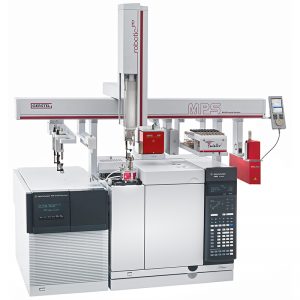A new fully automated thermal desorption (TD)-GC/MS method was developed for determination of formaldehyde and other airborne carbonyls as well as VOCs for material emission testing. The method includes an automated in-situ derivatization agent loading step prior to every sampling step, thus blank values are avoided. Pentafluorophenylhydrazine (PFPH) was used as derivatization agent and was automatically loaded onto Tenax TA adsorbent using a dynamic headspace (DHS) technique. Repeat use of Tenax TA adsorbent for loading PFPH and the background of PFPH-CH2O was validated, the usefulness of Tenax TA adsorbent for the analysis, as well as the storage behavior of PFPH loaded Tubes were investigated. The linearity of the formaldehyde calibration curve from 0.2 – 2.0 μg (corresponding to 8 – 81 nmol) for the PFPH/TD-GC/MS method was r2 = 0.9989 with average RSDs of only 1.4% (4 levels, n=5). The method provided good reproducibility. The limit of detection (LOD) for formaldehyde was calculated according to DIN 32645 to be 0.09 μg (3.0 nmol) and the limit of Quantitation (LOQ) was determined to be 0.25 μg (8.33 nmol). Emissions from a plywood sample and a commercially available candle were analyzed using the PFPH/TD-GC/MS method. Formaldehyde and the VOCs and SVOCs normally determined by Tenax/TD-GC/MS were all determined. Formaldehyde was detected in both sample types.
- Home
- About Us
- Products
- Automated Sample Preparation
- Advanced Analysis Technique
- Ion Chromatography
- Particle Size & Shape
- Zeta Potential Analyzer
- Surface Chemistry
- Spectroscopy
- Powder Characteristic
- Elemental Analyzer – Combustion
- Cleaning & Washing System
- Microwave Digestion System
- 3D Electronic Printing
- LabAlliance Instruments
- Services
- Application
- Contact Us
- Home
- About Us
- Products
- Automated Sample Preparation
- Advanced Analysis Technique
- Ion Chromatography
- Particle Size & Shape
- Zeta Potential Analyzer
- Surface Chemistry
- Spectroscopy
- Powder Characteristic
- Elemental Analyzer – Combustion
- Cleaning & Washing System
- Microwave Digestion System
- 3D Electronic Printing
- LabAlliance Instruments
- Services
- Application
- Contact Us
Automated Determination of Formaldehyde Emissions from Materials by On-Sorbent Derivatization and Thermal Desorption GC/MS
You are here:
- Home
- Lab Application
- Automated Determination of Formaldehyde Emissions…



